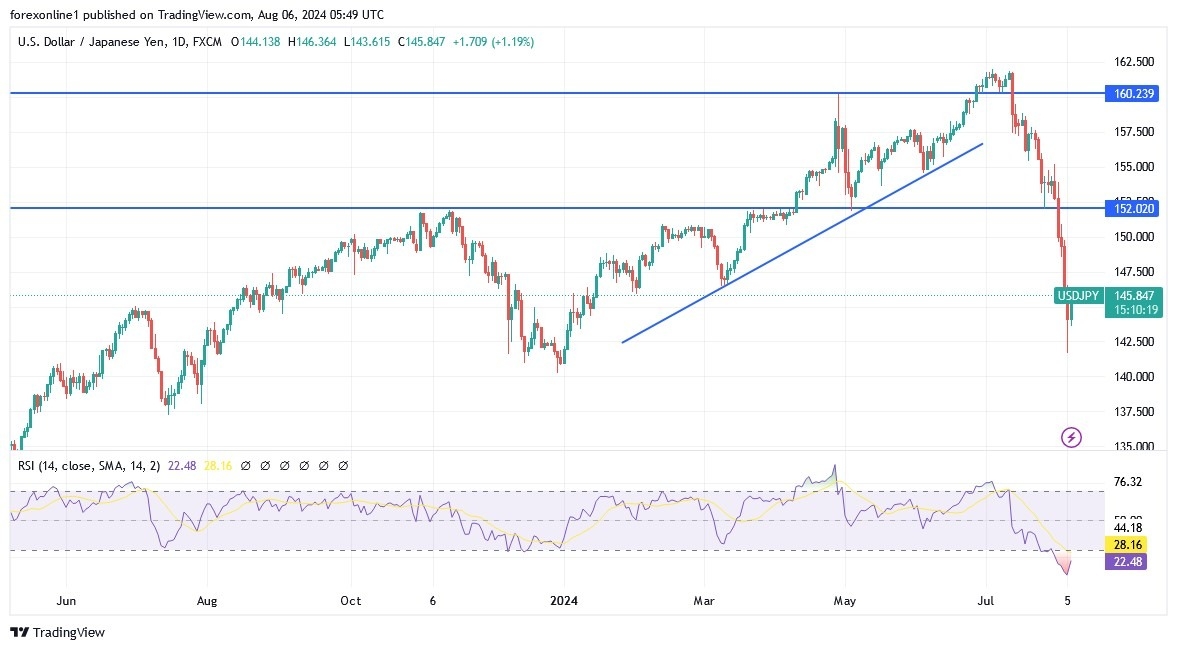- The Japanese yen has continued its sharp gains, jumping to 141.68 yen per dollar, reaching its highest level since early January 2024.
- This surge is fueled by bets that the Bank of Japan will raise interest rates further in the coming months, while the US Federal Reserve is likely to cut rates more aggressively.
- These expectations came after a weak jobs report raised recession fears in the United States, prompting markets to price in a larger 50 basis point interest rate cut by the Fed in September.

Meanwhile, the Bank of Japan raised its interest rate to 0.25% last week and signaled its willingness to raise rates further if the economy remains strong. Financial markets are betting on two more rate hikes this fiscal year ending in March 2025, with the next hike expected in December. Also, the central bank announced a plan to halve its monthly bond purchases over the next two years.
Elsewhere, data showed that Japanese authorities spent 5.53 trillion yen to support the currency through intervention in July.
According to reliable trading platforms, the yield on the benchmark 10-year Japanese government bond fell below 0.8%, hitting a four-month low, following a decline in US bond yields amid bets that the Federal Reserve will cut interest rates more aggressively after weak US jobs data raised recession fears. Also, Japanese government bond yields were pressured by safe-haven buying amid a global stock sell-off and a rapid unwinding of the yen carry trade.
Furthermore, the Bank of Japan’s plans to reduce bond purchases fell short of market expectations. Moreover, the Bank of Japan said last week that it would trim its monthly bond purchases to about 3 trillion yen a month in the first quarter of 2026. That would be a cut of about 400 billion yen per quarter, well below expectations of about 1 trillion yen per quarter.
Still, the Bank of Japan raised its benchmark interest rate to 0.25% last week and signaled its willingness to raise rates further if the economy remains strong.
According to stock trading platforms, US stock futures declined on Monday, with S&P 500 futures losing 3%, the Nasdaq 100 falling 4.8%, and the Dow Jones losing about 700 points amid growing concerns about a potential economic slowdown and recession in the United States. Concerns were raised last week after the disappointing manufacturing Purchasing Managers' Index (PMI) from the Institute for Supply Management, and fears intensified following the weekly jobs report. The Institute for Supply Management's services PMI, scheduled to be released later today, will provide further updates on the health of the services sector.
Meanwhile, weaker-than-expected earnings from leading tech companies and uncertainty surrounding the AI sector added to the negative sentiment. Nvidia shares fell by about 10% in pre-market trading, while other large-cap stocks also fell sharply, including Microsoft (-5.3%), Apple (-8.9%), Amazon (-5.7%), Meta (-6.6%), and Alphabet (-6%). Other large-cap decliners included Tesla (-7.5%), Broadcom (-8.5%), AMD (-5.4%), and Qualcomm (-5.8%).
Top Forex Brokers
USD/JPY Technical Analysis and Expectations Today
Based on the daily chart attached, USD/JPY’s losses were strong and sharp, pushing technical indicators into oversold levels. If the selling continues to the support level of 140.00, we will prefer to think without risk in buying the dollar against the Japanese yen. On the other hand, as we mentioned before, the resistance level of 150.65 will be important for the bulls to regain control. Technically, the currency pair will continue to be affected by the future policies of central banks and the extent of investors' appetite for risk or not.
Ready to trade our daily Forex analysis? We’ve made this forex brokers list for you to check out.
